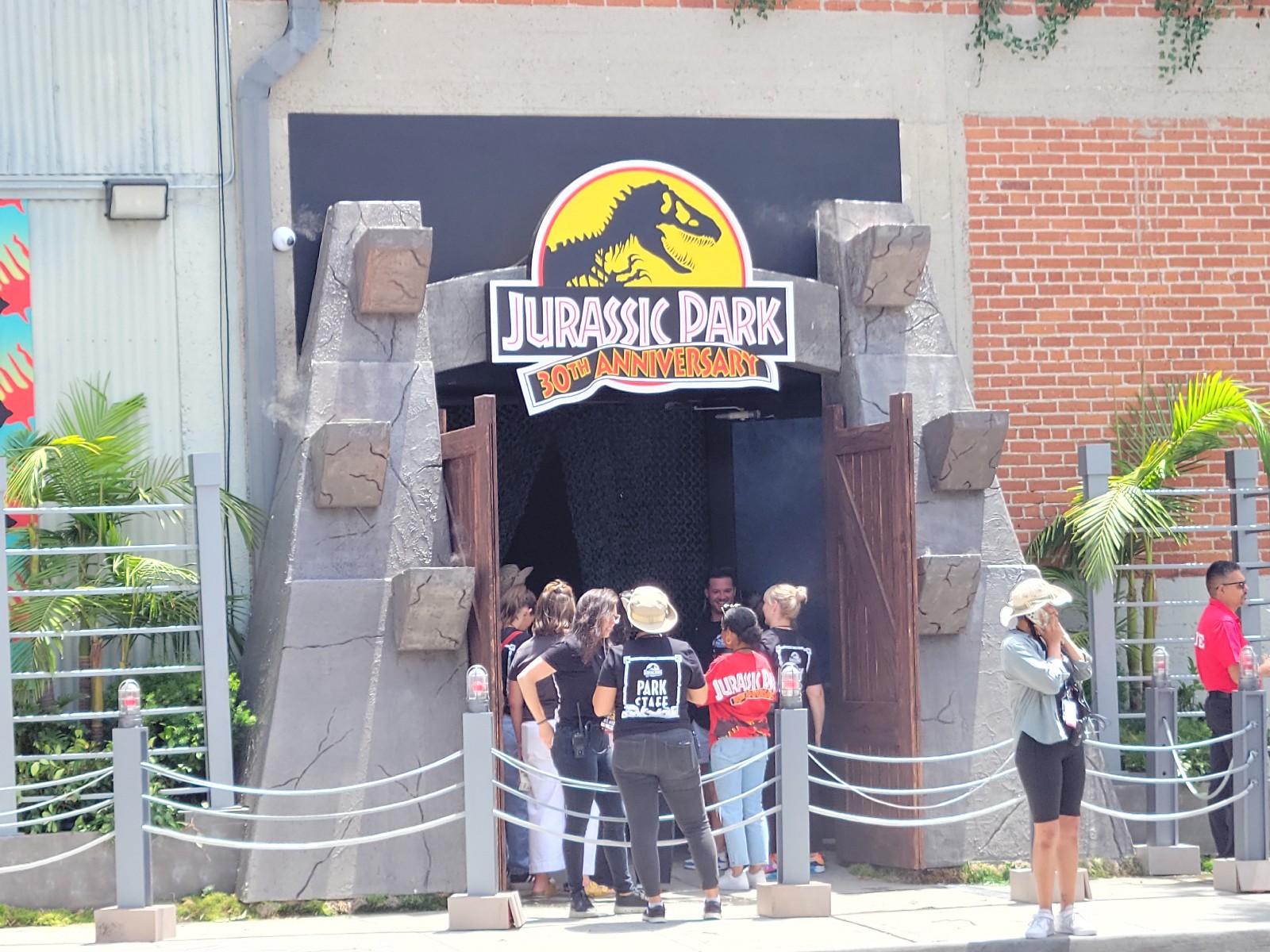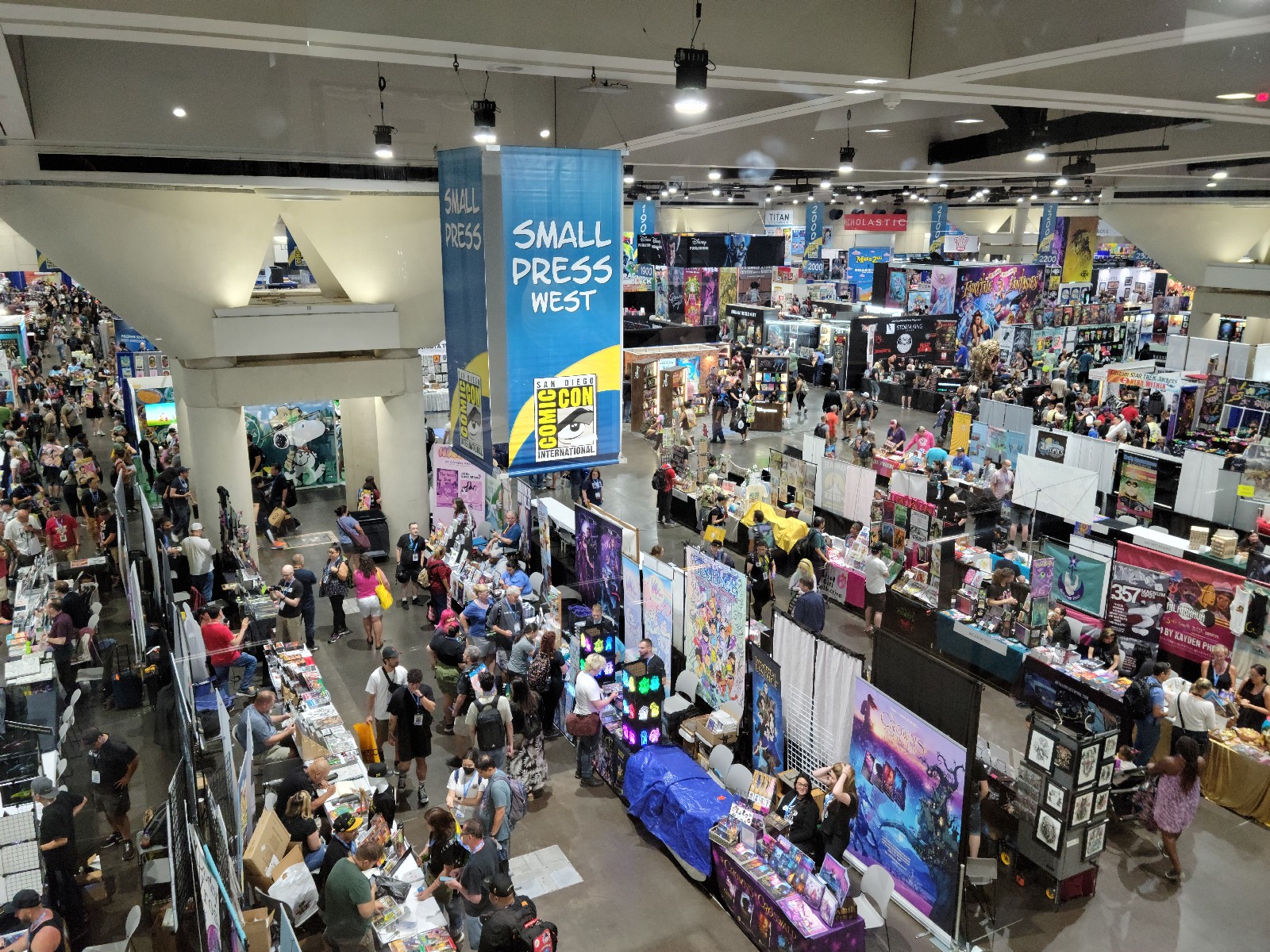This past weekend we attended Gateway 2015, which took place September 4-7, 2015. Gateway, a gaming convention, is held annually every Labor Day weekend, and is one of the three events that Strategicon puts on every year. The other two are Orccon, held every Presidents Day weekend, and Gamex, held every Memorial Day weekend. All events take place at the Hilton Los Angeles Airport. In this recap, Violet will take you through our experience getting to the convention, going through Registration, and playing our first demo, Titan. Then Josh will take over, giving you a rundown of Overlords of Infamy and Feline Fortunes! Finally, both Josh and Violet will share their final thoughts about their first time at Gateway.
Although we had heard of Strategicon’s conventions a couple years ago, it seemed like we were always busy every time one of the events came up, considering that they’re always on holiday weekends. But for the first time, we realized that we had some time on Saturday to check it out. So a few days before Gateway 2015, we emailed Strategicon inquiring whether we could get a Media badge, knowing it was a longshot due to the short notice. To our surprise, they emailed us back the next day, saying they would be delighted to have us!
If you follow our site, you’ll know that the events we cover are comic and pop culture related. Although we like to play board games and video games, we had never attended any sort of gaming convention, so this was new territory for us, and we had no idea what to expect.
As I looked through the schedule for Saturday, there weren’t many familiar games on the list. One familiar game was Ticket to Ride — though it was the Asia version, which we’ve never played. However, there was a demo scheduled at 9:00am that would teach you how to play the game, followed by a tournament in which you could play the game against others. I thought this might be a good option for us, as I figured we could probably pick up the new elements to the Asia version pretty easily, since we are already familiar with the base game, and have played the Europe version once. Josh was a little skeptical though, as he didn’t think we would be good enough to play in a tournament against serious players who have more experience playing the game. Personally, I thought we would be going up against other players who had just learned to play in the demo, so it wouldn’t be a big deal.
In any case, it turned out to be a non-issue, as we didn’t make it to the convention in time to join in on the demo anyway.
Parking and Registration
We got a bit later of a start Saturday morning than we had intended, leaving from our house in Orange County a little after 8:30am, so we didn’t end up arriving to the area until around 9:15am. At that point, we pulled into the Hilton parking lot, only to see the sign “Lot Full.” Luckily, we had been to Gallifrey One, the Doctor Who convention, in February, which takes place down the street at the Marriott, so we knew that the parking garage in between the Hilton and the Marriott was a good place to park. The only problem with that garage is that the parking spots are set up so that cars can double or triple park, so it’s tricky to find a spot where you won’t get blocked in. So we spent awhile driving around looking for a spot, and finally found one. We exited through the stairwell, and when the door closed behind us, we saw that it had no handle. About a minute later, Josh realized he didn’t have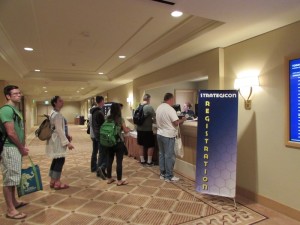 his wallet. So we had to find a different way to get back into the parking garage. We kept walking around and walking, but could not find another way to get to the stairwell. We saw an entrance with glass doors, but the sign says that the doors stay locked all day on Saturday! Finally, we found a way in to the main building, and took the elevators down that we had remembered taking during Gallifrey One. The moral of the story: don’t use sketchy stairwells, just take the elevator!
his wallet. So we had to find a different way to get back into the parking garage. We kept walking around and walking, but could not find another way to get to the stairwell. We saw an entrance with glass doors, but the sign says that the doors stay locked all day on Saturday! Finally, we found a way in to the main building, and took the elevators down that we had remembered taking during Gallifrey One. The moral of the story: don’t use sketchy stairwells, just take the elevator!
So we finally make our way over to the Hilton, and follow the signs to Registration. On one side, they were checking in people who were paying on-site, and on the other they were checking in people who had pre-registered. It seemed like everyone was paying on-site, so we were able to walk right up to the pre-registration side and get our badges immediately.
Getting Our Bearings
By this time, it was about 9:40am, so I looked at the schedule to see what was going on at 10:00am. I saw that there was a demo for a game called Titan, so we went to go look for that. The problem was that the schedule didn’t have a room listed for the location of the demo. So we thought maybe the last listed location might be the same for all the games listed below that location. In this case, that was Marina, so we went and found the Marina room. But when we got there, that didn’t look right. Also, we noticed that on the schedule that even if several games in a row were in the same room, the schedule would repeat the name of the room. For example, La Jolla room was listed 7 times in a row.
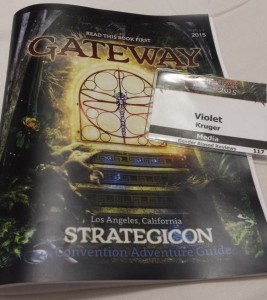 Our only other idea was that maybe it was in the Board Games room, so we found where that was, and noticed that there were flags at each table indicating what game was being played there. We saw the Ticket to Ride: Team Asia demo wrapping up, which looked like it had been a full table. That had also had a blank space on the schedule rather than having a room listed, which seemed to indicate to us that we were in the right place. We also noticed a table off to the side that had several sign up sheets. We saw the Titan 101 sign up sheet, and no one was signed up for it. We looked around for a pen or pencil to sign up, but there wasn’t one. Just then, someone showed up to the table who was running the Titan demo, and the guy working the table handed the sheet to him, telling him that no one had signed up for it yet. I told him that we were going to sign up, so they found us a pen and we signed up. The guy running the demo, who was a Scottish fellow in his 60s named Alasdair, decided to leave the sign up sheet there for a few more minutes, in case anyone else wanted to sign up. Then he collected his Titan flags, and we followed him to an empty table.
Our only other idea was that maybe it was in the Board Games room, so we found where that was, and noticed that there were flags at each table indicating what game was being played there. We saw the Ticket to Ride: Team Asia demo wrapping up, which looked like it had been a full table. That had also had a blank space on the schedule rather than having a room listed, which seemed to indicate to us that we were in the right place. We also noticed a table off to the side that had several sign up sheets. We saw the Titan 101 sign up sheet, and no one was signed up for it. We looked around for a pen or pencil to sign up, but there wasn’t one. Just then, someone showed up to the table who was running the Titan demo, and the guy working the table handed the sheet to him, telling him that no one had signed up for it yet. I told him that we were going to sign up, so they found us a pen and we signed up. The guy running the demo, who was a Scottish fellow in his 60s named Alasdair, decided to leave the sign up sheet there for a few more minutes, in case anyone else wanted to sign up. Then he collected his Titan flags, and we followed him to an empty table.
Titan Demo
We waited a few minutes while Alasdair set up the board, and when it became obvious that no one else would be joining us, he started the demo. Alasdair started off by asking us what we knew about Titan. Our answer was: nothing. He then asked us what made us interested in the game, which was basically that it fit our schedule and looked interesting. He then started explaining the game to us. There were a lot of rules, and it seemed really complicated. Through the course of him teaching us the game, we learned that the board we were playing on was the “old” version, and that there is a new version that looks a lot different and may have some different game play elements. He pointed out that this was why there were two flags: one reflecting the old game, and one reflecting the new game.
The board we were playing on was very worn, but still in playable condition, and the pieces looked like they had been handled quite a bit. Alasdair pointed out that this can be an advantage or disadvantage, depending on the player, as some pieces don’t get used quite as much as others, and players can figure out what you have if you’re using one of the whiter, not frequently used, pieces.
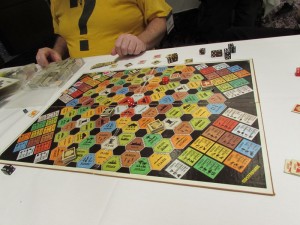 Another interesting thing we learned is that at past Strategicon events, since the rules are so “tight,” that Titan was the only game where the person running the tournament could play and be eligible to win dealer dollars. However, then there were some complaints about that, so this was no longer true.
Another interesting thing we learned is that at past Strategicon events, since the rules are so “tight,” that Titan was the only game where the person running the tournament could play and be eligible to win dealer dollars. However, then there were some complaints about that, so this was no longer true.
So, what is Titan about and how do you play it? Titan is a board of hexes, with varying terrains on each hex, such as Marsh, Tundra, Jungle, etc. Each hex has directional arrows showing you which way you can go if you land on that particular hex. There are different creatures associated with each terrain, and you want to go around “recruiting” creatures into your army, such as Ogres, Gargoyles, Centaurs, etc., as different creatures have different strengths. Based on what creatures you have, and what terrain you land in, will allow you to recruit other creatures. Eventually, you battle against the other players.
But the board itself is not the only location of game play. When you go into battle with someone, which is when you’re both on the same hex, another aspect of the game comes into play. There are separate sheets of paper related to each type of terrain. Each sheet of paper has additional hexes with further elements of game play, such as a wall, or spaces that are related to that terrain which creatures native to that terrain would have an advantage.
By the time Alasdair got finished explaining everything to us, we only had time for each of us to take one turn before the one-hour session was over. At that time, 11:00am, a Titan tournament was scheduled to start. A few minutes before time was up, a guy that was signed up for the tournament sat down and watched our progress, commenting and helping us through our turn. Alasdair and this other guy said we were welcome to stay and participate in the tournament, but that we’d probably just be “cannon fodder.” Alasdair suggested that if we stayed and watched the tournament, we could learn to play the game better. So we stepped aside and let the tournament players take their seats. There was one more person that they were waiting on, so we decided to go walk around the Dealers Room and come back.
The Dealers Room was pretty small, and took us about 5 minutes to walk around. It was mostly board games for sale, though there were a few tables with merchandise. As we exited the Dealers Room, someone in the hall called us over to try a demo. I’ll let Josh tell you about that.
Overlords of Infamy
The second game we ended up playing was a startup game called Overlords of Infamy. Violet and I happened to be wandering through the Hilton checking out the various activities, and a nice guy named David asked us to try a game out. I was hesitant, but Violet decided we should give it a try. We sat down, and there were two other players set to play as well. David gave us some basic instructions for the game, and then we proceeded to play within a few minutes. This is actually a great way to get me into a game–I prefer games that have simple rules, because anyone can be ready to play in a matter of a few minutes, rather than having to listen to an hour explanation before new people get a chance to try it out. Since Violet and I aren’t hardcore board gamers, and our friends aren’t either, something quick and easy usually goes better than long and drawn out.
So below is a very in depth (perhaps too in depth?) look at how to play the game. I am not sure if/what rules might change since the game isn’t actually being mass-produced yet, and since Violet and I only played once, there might be some minor things I got wrong, but in general, since the game is easy to learn, the below is pretty much how the game goes. Before you read that wall of text though, I wanted to provide my thoughts on the game.
Firstly, the basic concept of the game is pretty fun. You get to play from the “bad guy’s” point of view, and it’s done in a silly, jovial manner. One of the “missions” I had to complete was something to the effect of, “produce a long drawn out, addictive television show and cancel it before the season finale.” This cracked me up, because I felt like I related to the card pretty well. There’s other various humorous cards, and it is always a good way to lighten the game for a few chuckles.
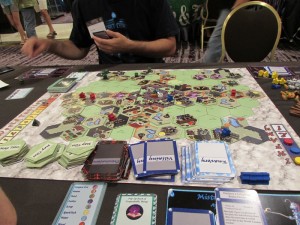 Secondly, it was pretty fun building your own little evil empire. I like games where you “build” stuff. In this game, through the various resource hexes, you get to build your own little empire. Overall, I find this game a refreshing board game, that takes a lot of little bits of other games and melds them into something unique, and entertaining. There’s aspects of Carcassonne, with the land building, elements of Ticket to Ride with the trying to complete goals, along with Settlers of Catan for resource gathering. I would certainly suggest checking out their webpage here, and their Kickstarter when it eventually goes live. If this review sparked any interest in the game, and you want to learn a bit more about the rules, below is a much further in depth look at gameplay and objects to the game I learned, in the hour or so we spent playing.
Secondly, it was pretty fun building your own little evil empire. I like games where you “build” stuff. In this game, through the various resource hexes, you get to build your own little empire. Overall, I find this game a refreshing board game, that takes a lot of little bits of other games and melds them into something unique, and entertaining. There’s aspects of Carcassonne, with the land building, elements of Ticket to Ride with the trying to complete goals, along with Settlers of Catan for resource gathering. I would certainly suggest checking out their webpage here, and their Kickstarter when it eventually goes live. If this review sparked any interest in the game, and you want to learn a bit more about the rules, below is a much further in depth look at gameplay and objects to the game I learned, in the hour or so we spent playing.
Also fun is the ability to complete missions while at the same time trying to mess up your opponents. The hero component of the game along with the “Espionage” phase are a good way to keep the leaders in check to prevent a runaway game, while at the same time provides a fun way to mess with them.
So the basic premise for the game is this–each player chooses a villain to play (and each villain has their own unique powers). This villain’s goal is to wreak as much misery as possible across the land, which is essentially what the game board is. The board is regulated to four quadrants, each player regulated to one of the four. Each player’s quadrant of land is made up of hexes, which players must improve upon in order to “exploit the land,” basically trying to mine various resources to use to carry out their nefarious plots.
After each player has chosen their villain, they also choose a plot card. There are three decks of plot cards, but to start out with, players can only choose from the beginning pile, called “Knavery.” These are fairly easy tasks to complete, but yield few “misery” points (which are what is totaled up at the end of the game to determine the winner). As the players gain Infamy, they eventually get to draw from the other two decks, which provide harder tasks, but the point values for misery points increase a lot. Each player gets to choose two plot cards, then discard the one they do not want to pursue.
The one other caveat to the game is this: How can you have a bunch of villains without a hero? Well there is a hero, and his goal is to try to stop the villains from their treacherous acts! The hero starts off in his castle, and he is actually controlled by the various players, depending on where the marker is on the “World Tracker” (I’ll explain the world tracker in a second). After the World Tracker hits the numbers 3, 6 and 9, the next player whose turn it is gets to move the hero. When the hero is moved he can perform a few actions. If he moves to an open piece of land, he can destroy that piece of land. If he lands on a place with a villain’s “lackey” (more on these in a second two!), the lackey is killed. After the heroes performs any of these actions, he heads back to his castle, occasionally bringing some of the spoils from his mission back to his lair. There are circumstances in which the villain can steal these, which I am still a bit hazy on, since we only played the one time.
So I mentioned world events earlier, which basically happens when the hero reaches 10 on the “World Tracker.” This tracker is advanced forward when villains do various things, such as mine the resources from their land they are exploiting. “World Events” happen on the 10th number on the tracker, and each World Event causes something in the game to happen. From ones we saw, they either hurt or helped a single villain, or the villains as a whole, or were just some silly thing (for example, we drew one that prevented us from talking the entire round, which I of course botched, and lost an action on my next turn). David explained to us that 10 of these World Events end the game for a four player game, and 8 for an 3 player game. When the game ends, the point totals are added up, and whoever has the most wins the game.
Actual Gameplay
So the game starts with 3 lackeys in your “barracks” tile, which is attached to your start tri-hex thingy. At the beginning of your turn, you would move the hero, if the right conditions were met, and if not, you proceed with your actions, of which you get 3 in most cases. The basic actions are, “exploit the land,” send out a lackey to gather resources, or recall a lackey who has already gathered.
Exploiting the Land
So, exploiting the land is basically choosing two hexes from a pile, choosing which one you like, and placing on the map, in your quadrant, adjacent to one of your other placed tiles. On these tiles are various resources to mine, such as “Spark-Tech,” “Scrap,” “Wood,” “Food,” or even additional lackey “village” spots, etc. Some tiles have other things to protect from a hero, either a pit for the hero to fall in, which delays his movement, or a wall which the hero must travel around, and cannot go through. Exploiting the land is essential for the second move, which is harvesting this new land you just “exploited.”
Gather Resources
I don’t remember the exact term in the game used for this, but on various tiles which have been placed on the board from “exploiting,” a player can then use an action to send out a lackey to gather that resource. A player would move a lackey pawn from their barracks, to the land they want to gather, and take a resource token that matches. After the lackey has been sent out, they can’t be used again until they are recalled.
Recalling a Lackey
The last action move is recalling a lackey, which basically brings a lackey back to the barracks, so they can be used again to gather resources.
Espionage Phase
After the action phase is done, the player’s turn moves to the “Espionage” phase, which occurs only if two of the villains lands are connected at the contested hexes. Contested hexes basically run like a cross through the game board, and provide the borders for each villain’s quadrant. These hexes contain resources that can be mined by any villain who has exploited land next to that hex. Depending on the level of Infamy, the players can do various nefarious acts to their rivals, from looking at their plot cards, to figuring out ways to slow resource gathering, and even stealing some.
Completing a Plot Card, and Completing a Turn
As players collect these resources, they will complete plot cards. More difficult cards require relics as well, which are held closer to the hero, which makes them a little trickier to retrieve. It also takes two actions to retrieve, making them a little more expensive to gather. But the plot card’s point value is quite a bit higher, so the risk might be worth the reward! But that is essentially all there is to a turn. Things go around the board from there. The biggest things people seem to have to keep track of is the number of actions a person takes, the times when the marker on the World Tracker is supposed to advance, and what order to do things in such situations as if a plot card and World Event happen at the same time.
Feline Fortunes
After we finished playing Overlords of Infamy, we ate lunch, wandered around a bit more, and had hoped to sign up for a board game demo we saw in the schedule for a game called “Kingdom Builder” at 2:00pm. Unfortunately, a lot of other people had the same idea, as the signup sheet was completely full, as was the table the game was being demo’d at. Too bad.
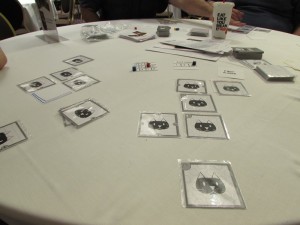 But as we wandered a bit more, we were asked to play another game that would be up for Kickstarter soon. This game was titled “Feline Fortunes,” and was marketed to us as a fun, “light” card game. The game was in the very preliminary stages, as the cards were printed on basic paper and put in plastic sleeves, but the concept of the game as well as the rules seemed to be fully flushed out. There is even a funny “backstory” to the game–players are “cat-sitters” for a wealthy man, who has way too many cats. The players are trying to keep from losing their patience as they juggle and shuffle these cats on their “laps,” while at the same time trying to sabotage other cat-sitters by throwing cats at their opponent. It’s certainly a unique story idea!
But as we wandered a bit more, we were asked to play another game that would be up for Kickstarter soon. This game was titled “Feline Fortunes,” and was marketed to us as a fun, “light” card game. The game was in the very preliminary stages, as the cards were printed on basic paper and put in plastic sleeves, but the concept of the game as well as the rules seemed to be fully flushed out. There is even a funny “backstory” to the game–players are “cat-sitters” for a wealthy man, who has way too many cats. The players are trying to keep from losing their patience as they juggle and shuffle these cats on their “laps,” while at the same time trying to sabotage other cat-sitters by throwing cats at their opponent. It’s certainly a unique story idea!
Violet and I took a bit to understand the rules to this game. Basically there are two phases to a round. Players start with a specific number of “Patience” which is lost when certain things happen in the game. The game starts with passing out four cats to each player, and each player tries to figure out the best place to apply these cats to their board, each taking turns until all four cats are placed. The “board” consists of a 3 square by 3 square grid (think tic-tac-toe). The trick is, each cat has a unique component to their card. Some cats “push” others a certain way. Many of the cats have arrows pointing away from the center, in a specific direction. If those arrows point directly to an adjacent cat, then that adjacent cat is moved. The point value of Patience is lost if the cat moves on the lap, and remains on the game board.
Now, if the cat us pushed off of the game board, the cat then is put into a “toss” pile, which will take place in phase 2. As for other cats’ abilities, there were ones that exploded other cats, mirrored other cats’ abilities, and caused cats to rotate around the board. All these abilities had to be placed carefully as they could be detrimental to the player, or used to sabotage the opponent.
After each player has taken their turns placing the cats on their board, and avoided losing as much patience as possible, the real havoc begins with players “tossing” cats at their opponent. Players could “toss” up to three, taking turns each time until all cats, up to three, are tossed. When the cats are tossed, whatever abilities are on the cards, will affect your opponent’s board when placed. Ideally from the limited time we had with the game, the best strategy would be to try to set up combos with the three cats to maximize the amount of Patience lost by the opponent.
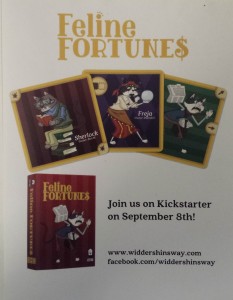 After the cat-tossing phase, it’s back to the first phase, with the players switching who goes first. At first, when trying this game, I was pretty underwhelmed. This was mostly because of what I thought was convoluted abilities for the various cats. But after about 5 minutes, everything seemed to click, and my interest in the game started to increase. I began looking intently at my board to see how I would be able to minimize the damage Violet could cause to me, while at the same time trying to determine how to cause total cat chaos on hers. So again, this game ticked one of the biggest requirements I have for a board game–having simple enough rules but allowing for a ton of strategy. If I were to play this game more, I can see myself spending a good 5 minutes analyzing my cat cards to see the best way to maximize my potential to come ahead that round. At the same time, if the art is done well for the game, I can see this being a fun game for a wide age group, and could be a game that you just pick up and play a quick game, or one where you can get deep in thought on determining how best to claw your opponent up.
After the cat-tossing phase, it’s back to the first phase, with the players switching who goes first. At first, when trying this game, I was pretty underwhelmed. This was mostly because of what I thought was convoluted abilities for the various cats. But after about 5 minutes, everything seemed to click, and my interest in the game started to increase. I began looking intently at my board to see how I would be able to minimize the damage Violet could cause to me, while at the same time trying to determine how to cause total cat chaos on hers. So again, this game ticked one of the biggest requirements I have for a board game–having simple enough rules but allowing for a ton of strategy. If I were to play this game more, I can see myself spending a good 5 minutes analyzing my cat cards to see the best way to maximize my potential to come ahead that round. At the same time, if the art is done well for the game, I can see this being a fun game for a wide age group, and could be a game that you just pick up and play a quick game, or one where you can get deep in thought on determining how best to claw your opponent up.
The game really clicked for me about 2/3 of the way in and I managed to squeak a victory over Violet. If you’re interested in the Kickstarter for Feline Fortunes, click here to check it out.
After the game was over, we wandered around the hall a bit more, and admired a lot of the work people had put into their sets for various RPGs. We checked the schedule in hopes for another demo, but again everything was full, and Violet and I had a USC Football game to get to. So we decided to wander a bit more, then headed out for the day.
Josh’s Final Thoughts on Gateway 2015:
It was actually a lot of fun playing the few games we got to. Since it was our first time to this convention, I felt a little intimidated, as I didn’t know what to expect. Everyone we met seemed nice enough though, and we learned that we really need to learn to sign up sooner for games we would like to demo. Next time we head to this event, we will have to set aside more time as well, so we can have some additional time for schedule. All in all I did have fun with it though, and look forward to next time!
Violet’s Final Thoughts on Gateway 2015:
I was both excited and nervous going into Gateway 2015. As I mentioned above, this was our first time attending any sort of gaming convention, plus we were trying it out on our own, without knowing anyone there, without having anyone to guide us as to where things are or what to do, so this was all new to us, which is always nerve wracking. From the get-go we were lost just trying to get to our first event, which didn’t have a specific room listed next to it, which might be intuitive to old pros, but threw us newbies off for a few minutes. At first, it seemed like many of the people there already knew each other, which initially made me feel intimidated, but soon I saw that they were all very welcoming, and that actually not everyone knew each other. I did feel like it was an intimate convention, as the few people we met, we kept running into while wandering around! Plus, it was nice to see people of all ages there enjoying themselves, from children on up to adults well into their 60s or maybe even older!
I also learned that the people running the demos have different teaching styles. With Titan, the style was to try to explain everything and then have us play, whereas with Overlords of Infamy and Feline Fortunes, it was to explain a little, but have us start playing, then explain more as we went along. I prefer the latter of the two styles, as I felt like I grasped both of those games better than I did Titan. That is a shame, as I would have liked to have more time to play Titan, since it seemed along the lines of a game we’d be interested in. Unfortunately, we only got to play one turn each before the demo time was up.
The other thing we learned was that you need to sign up early for the demos! And probably the tournaments too. The sign up sheets do fill up, especially later on in the day. Now we know for next time! Hopefully next time we come to one of Strategicon’s events, we can devote more than just one day, as it seems like it would be a fun environment to immerse yourself in for the entire weekend! Now that we know the lay of the land, so to speak, maybe we won’t feel so intimidated next time, and might actually sign up for some tournaments. Overall, I had a fun time and definitely want to come back!














